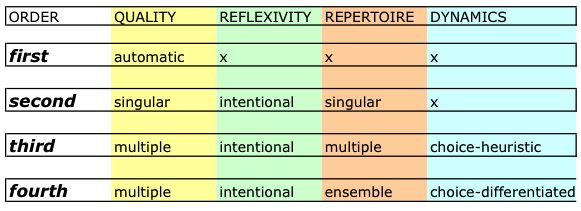Hybridity
As ecological success is measured
by the capacity of our planet to support all life forms,
urban design success should be measured
by its capacity to support humanity.
Learning from best practices,
an Integral Urbanism offers guideposts along that path
toward a more sustainable human habitat.
In contrast to escapist, cynical, or purely mercenary tendencies,
Integral Urbanism aims to heal wounds
inflicted upon the landscape
by the modern and postmodern eras
as manifest in:
Visually unappealing places
Impoverishment of public space and heightened perception of fear
Diminished sense of place and sense of community &
Environmental degradation.
To accomplish this, Integral Urbanism demonstrates five qualities:
Hybridity
Connectivity
Porosity
Authenticity
Vulnerability
Hybridity and Connectivity bring activities and people together, rather than
isolate objects and separate functions. These qualities also treat people and nature
as symbiotic—as well as buildings and landscape—rather than oppositional.
Porosity preserves the integrity of that which is brought together while allowing
mutual access through permeable membranes, rather than the modernist
attempt to dismantle boundaries or postmodernist fortification.
Authenticity involves actively engaging and drawing inspiration from actual social
and physical conditions with an ethic of care, respect, and honesty. Like all healthy
organisms, the authenti-City is always growing and evolving according to new
needs that arise thanks to a self-adjust ing feedback loop that measures and monitors
success and failure.
And Vulnerability calls upon us to relinquish control, listen deeply, value process
as well as product , and re-integrate space with time.
connectivity
In contrast to the master-planned functionally-zoned city
which separates, isolates, alienates, and retreats,
Integral Urbanism emphasizes
connection, communication, and celebration.
As we are a part of nature,
so are our habitats including our cities.
Over the last century, however,
urban development has treated the city as a machine
for efficiently sheltering and protecting
and for moving people, money, and goods.
The city-as-machine approach has privileged building upon
a tabula rasa, or clean slate.
This is manifest in leaving older cities behind
to build further out on pristine or agricultural land.
It is also manifest in razing large swaths of older cities to build anew.
Another by-product of the quest for efficiency is zoning.
Introduced one century ago as indust rial product ion and the car
were transforming the urban experience,
zoning segregated funct ions
that had been integrated
from t ime immemorial.
As people are mutually interdependent, however,
so are our activities as expressed in city form.
Cities and communities only thrive (are only sustainable)
when these interdependencies are allowed to lourish.
patterns
We are now belatedly recognizing the problems
wrought by the clean-slate tendency and land-use zoning.
However well-intended, these efforts to “renew” our cities
and render them more efficient have gone too far,
ult imately draining the life from them and cont ribut ing
to threaten our sense of community, security,
and physical and emotional health.
Rather than neglect, abandon, or erase our urban heritage, Integral Urbanism
preserves buildings, neighborhoods, and natural landscapes that we value;
rehabilitates, reclaims, restores, or renovates what is underperforming;
and adds what we do not have yet but would like,
as informed by effective community involvement.
Whether applied to exist ing urban fabrics or new development ,
I ntegral Urbanism activates places
by creating thresholds—places of intensity—
where a range of people and activities may converge.
Providing places to congregate along with synergies and eficiencies,
I ntegral Urbanism offers settings—while also liberat ing t ime and energy—
for collaborat ively envisioning and implement ing desired change.
The result is:
more conservation & less waste,
more quality public space & less distrust and fear,
more quality time & less “ screen time” and commuting time,
more proaction & less reaction.
Whereas the modern paradigm discouraged convergences
through its emphasis on separation and control,
this new paradigm encourages them.
Convergences in space and time
of people, activities, businesses, and so forth
generate new hybrids.
These hybrids allow new convergences and the process continues.
This is, in fact, the definition of development.
From the machine as model (modernism) ,
to cities of the past as model (postmodernism) ,
Integral Urbanism finds models simultaneously in
ecology and new information technologies such as
thresholds, ecotones, tentacles, rhizomes, webs, networks,
the World Wide Web, and the Internet .
I t also reveals a fascination with the border, edge, and in-between,
as concepts as well as actual places.
In contrast to earlier models, these suggest
the importance of connectedness and dynamism
as well as the principle of complementarity.
On the ecological threshold where two ecosystems meet, for instance,
there is competition and conlict along with synergy and harmony.
There is fear along with adventure and excitement .
It is not about good or bad, safety or danger, pleasure or pain, winners or losers.
All of these occur on the threshold if it is thriving.
Integral Urbanism veers away from master planning which,
in its focus on cont rolling everything,
ironically tends to generate fragmented cities without soul or character.
Instead, Integral Urbanism proposes more punctual intervent ions
that have a tentacular or domino effect,
catalyzing other interventions in an ongoing dynamic process.
If master planning were a form of surgery on an anaesthetized city,
Integral Urbanism might be a form of acupuncture on a fully alert and engaged city.
By opening up blockages along “urban meridians,”
just as acupuncture and other forms of bioenergetic healing
open blockages along the energy meridians of our bodies,
this approach can liberate the life force of a city and its vibrant communities.
porosity
While integrat ing the functions that the modern city separated,
Integral Urbanism also seeks to integrate:
ln conventional notions of urban, suburban, and rural to
produce a new model for the contemporary city
ln design with nature
ln local character with global forces
ln the design professions and
ln people of different ethnicities, incomes, ages, and abilit ies.
Integral Urbanism is about :
Networks not boundaries
Relationships and connections not isolated objects
Interdependence not independence or dependence
Natural and social communit ies not just individuals
Transparency or translucency not opacity
Permeability not walls
Flux or low not stasis
Connections with nature and relinquishing control,
not continuous.
While integrating the functions that the modern city separated,
Integral Urbanism also seeks to integrate:
ln conventional notions of urban, suburban, and rural to
produce a new model for the contemporary city
ln design with nature
ln local character with global forces
ln the design professions and
ln people of different ethnicit ies, incomes, ages, and abilit ies.
Integral Urbanism is about :
Networks not boundaries
Relationships and connections not isolated objects
Interdependence not independence or dependence
Natural and social communities not just individuals
Transparency or translucency not opacity
Permeability not walls
Flux or low not stasis
Connections with nature and relinquishing control,
not controlling nature
Catalysts, armatures, frameworks, punctuat ion marks,
notional products, master plans, or utopias.
authenticity
The urban and environmental challenges of the last century
have prompted a reconsiderat ion of values, goals, and means of achieving them,
particularly over the last decade.
In contrast to the fast-paced more-is-more mentality,
the appeals of simplicity, slowness, spirituality, sincerity, and sustainability
are clearly on the rise.
Side by side with the still prevalent reactive tendencies of
form to follow fiction, finesse, finance, and fear,
myriad proactive initiatives from a wide range of contributors
to shaping the environment are shifting the paradigm toward integrat ion.
Although there remain numerous
obstacles along this path, we are
nonetheless passing through a rare
historic moment when what is good
for urban growth and development
is aligning with polit ical, economic,
and social trends.
We have been coming full circle or,
more accurately, full spiral.
Learning from the inherent wisdom
of nature and cities of the past ,
we are infusing it with contemporary
sensibilities.
Rather than choosing to cont inue or abandon the modern project ,
our hyper-rational reliance upon information technologies along with
a simultaneous revalorization of process, relat ionships, and complementarity
is conspiring to eradicate the either/ or proposit ion.
We are doing both simultaneously,
each providing feedback for and adjusting the other accordingly,
holding potential for achieving integration at another level.
The modern era divided the world and our thinking about it into fragments
and our landscape followed. We are suffering the results.
Integrating disciplines and professions,
Integral Urbanism seeks to mend seams and darn holes
in the urban and social fabrics.
Resolutely refusing to idealize the past or escape the present ,
Integral Urbanism envisions and realizes
a new integration for an enriched future.
integration
Crises and stress incite growth and change in all life forms.
The kind of change that occurs may support or detract from
the health and well-being of the system depending
upon its level of resilience and intelligence.
Applying the five qualities of Integral Urbanism
can offer the soul food necessary
for our cities and communities
to blossom and truly thrive.
Not merely
—
(from the Introduction)
In Western society, generally, we are witnessing a gradual reorientation
toward valuing slowness, simplicity, sincerity, spirituality, and sustainability in
an attempt to restore connections that have been severed over the last century
between body and soul, people and nature, and among people. For architects
and planners, this has been apparent in the shift from the machine as model
(Modernism), to cities of the past as model (Postmodernism), to seeking models
simultaneously in ecology and new information technologies (e.g., thresholds,
ecotones, tentacles, rhizomes, webs, networks, the World Wide Web, the
Internet). Along with these new metaphors, there has been a fascination with
the border, edge, and in-between, as concepts as well as actual places.
In contrast to the earlier models that bespoke aspirations for control and
perfection, these current models suggest the importance of connectedness and
dynamism as well as the principle of complementarity. On the ecological
threshold, where two ecosystems meet, for instance, there is competition and
conflict but also synergy and harmony. There is fear but also adventure and
excitement. It is not about good or bad, safety or danger, pleasure or pain,
winners or losers. All of these occur on the threshold if it is thriving.
For me, the smart community possesses the cognitive and poetic and expressive and creative capacities, thus the chops, to both contest the normal paths of low developmental resistance and instigate visions of future community that require the community to be smart. Another way of putting this is: the people in the community are more cognitively advanced than the ‘conventional’ people who want to develop the community. I add to this the potential for the people in a community to also be more advanced artists, entrepreneurs, care-givers, and ethicists. However, the challenge is, as I see it, that the smart community is necessarily reflective, much less egocentric, and, (as Melanie Klein would have it,) depressive; depressive meaning open and constructively related to reality-as-it-presents-itself.





